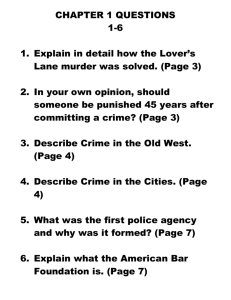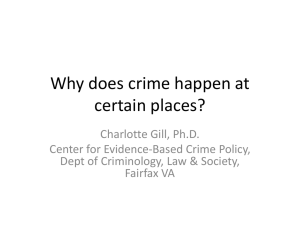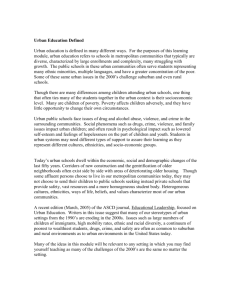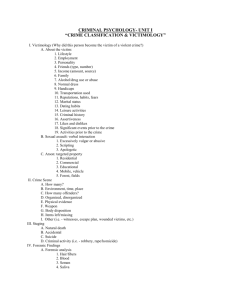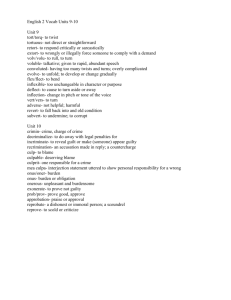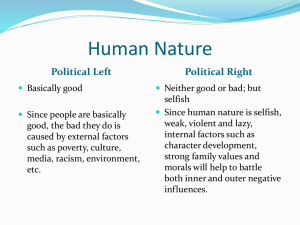home
advertisement
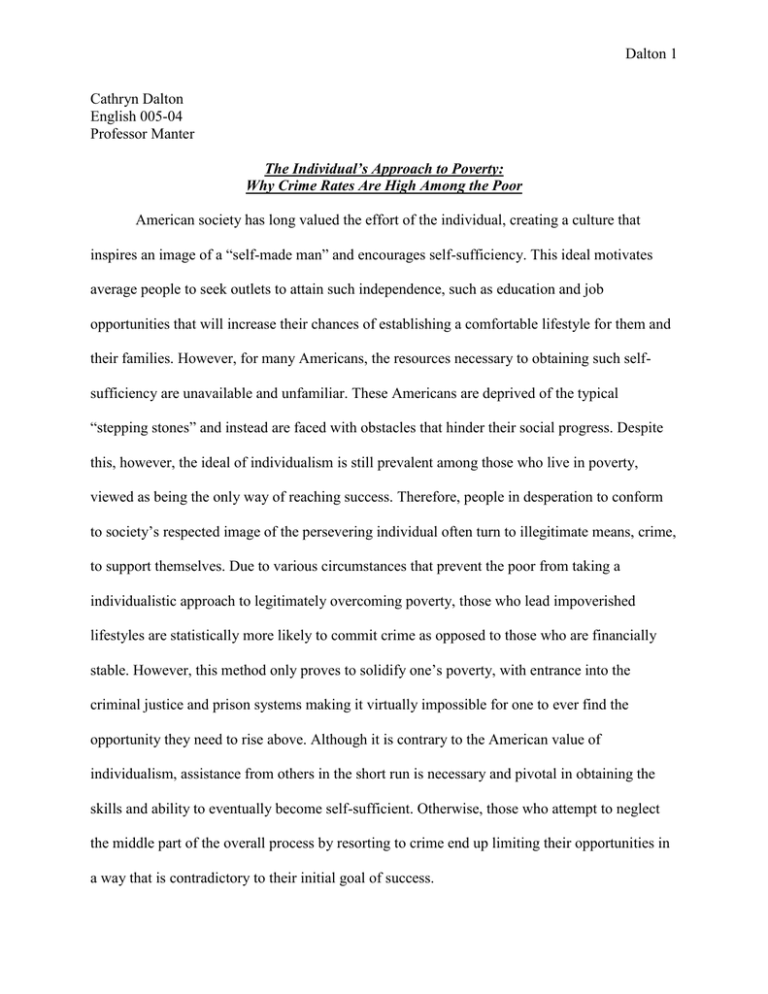
Dalton 1 Cathryn Dalton English 005-04 Professor Manter The Individual’s Approach to Poverty: Why Crime Rates Are High Among the Poor American society has long valued the effort of the individual, creating a culture that inspires an image of a “self-made man” and encourages self-sufficiency. This ideal motivates average people to seek outlets to attain such independence, such as education and job opportunities that will increase their chances of establishing a comfortable lifestyle for them and their families. However, for many Americans, the resources necessary to obtaining such selfsufficiency are unavailable and unfamiliar. These Americans are deprived of the typical “stepping stones” and instead are faced with obstacles that hinder their social progress. Despite this, however, the ideal of individualism is still prevalent among those who live in poverty, viewed as being the only way of reaching success. Therefore, people in desperation to conform to society’s respected image of the persevering individual often turn to illegitimate means, crime, to support themselves. Due to various circumstances that prevent the poor from taking a individualistic approach to legitimately overcoming poverty, those who lead impoverished lifestyles are statistically more likely to commit crime as opposed to those who are financially stable. However, this method only proves to solidify one’s poverty, with entrance into the criminal justice and prison systems making it virtually impossible for one to ever find the opportunity they need to rise above. Although it is contrary to the American value of individualism, assistance from others in the short run is necessary and pivotal in obtaining the skills and ability to eventually become self-sufficient. Otherwise, those who attempt to neglect the middle part of the overall process by resorting to crime end up limiting their opportunities in a way that is contradictory to their initial goal of success. Dalton 2 The tradition of American individualism has been present throughout society since its formation. In our capitalistic society, value is assigned to private goods and businesses, and those who make better for themselves without the help of others are held in high esteem. A prime example of this is Horatio Alger’s story of Ragged Dick, a young boy who, by seeking out opportunity, manages to lift himself up out of poverty with little help from others. Alger encourages the American mentality of picking oneself up “by their bootstraps”, praising the man who is able to exemplify dignity and strength in obtaining economic stability. However, the “individualistic” approach to poverty is not always plausible or realistic. A lack of resources, especially jobs, often hinders the American poor from making the money they need to sustain themselves, compelling them to commit crime out of a strong need for financial stability that does not involve reaching out to others for help. There is a direct correlation between employment access and crime, according to a case study done by William Minor and Fahui Wang in Cleveland in 1990. They found that “the less accessible jobs are, the more appealing crime becomes as an alternative” (Minor and Wang 446). In areas where physical access to legitimate jobs is limited, residents often turn to crime to achieve desired monetary goals, thus raising the crime rate in their area (Minor and Wang 435). Physical access includes more than just the literal inability to access jobs due to transportation issues and the like: it also refers to a lack of resources that would qualify someone for legitimate work, such as “inadequate education or training, racial discrimination, lack of knowledge of job opportunities, closed hiring practices, and so forth” (Minor and Wang 436). The need for money is a definite motivation to commit crimes such as theft or lucrative involvement in illegal trade businesses, like the “drug game”. When the poor do not qualify for legitimate work, or they are unable to obtain it, alternative ways of making money are sought out. Also, distance to and from work often factors Dalton 3 into one’s decision to find and keep a legitimate job. Things that are taken into consideration are travel costs, time, and whether or not the jobs are worth these things (Minor and Wang 437). Sometimes, the crime takes place closer to their home than the places where legitimate work is available. Oftentimes, the poor realize the benefits of working an illegitimate job as opposed to a legitimate one, and for that reason choose to engage in crime. (Minor and Wang 435). This is also known as the “strain theory”, or the tendency of the poor to undertake “illegitimate means to obtain legitimate goals” (Reid 55). The already unemployed also have a higher probability to commit crime because there is no job at stake for them. If they were to get caught engaging in criminal behavior, they do not have much to lose (Minor and Wang 435). A broken educational system leaves the poor without the qualifications they need to obtain work, and therefore the poor of a capitalist system often have no choice but to commit crime in a society where money is most important. Most criminals have very little educational background, with “state prisoners averag[ing] just a tenth grade education, and about 70 percent have no high school diploma” (Western and Petit). Without a decent educational background, one cannot meet the qualifications necessary for decent paying jobs. Therefore, resorting to crime yields benefits from work with very little qualifications necessary. A lack of resources, such as education and jobs, in poor communities prevents the poor from obtaining what they need in order to adapt to society’s image of the “rugged individual”. The means necessary to reach this goal are denied of the poor, causing them to find other ways of becoming self-sufficient that do not require what is unavailable to them, namely crime. The poor view themselves as separate from mainstream society, forced to find their own individual methods of obtaining success. They therefore create an environment unique to them and their circumstances that focuses on crime as the poor man’s individual approach to self-sufficiency. Dalton 4 The poor often feel marginalized and isolated from society, due to feelings of alienation and a concentration on the individual. The poor sometimes feel they need have no one to rely on but themselves, creating a self-sufficient attitude and environment that causes them to resist reaching out for help in obtaining legitimate work. The poor understand the value American society places on “pulling yourself by your bootstraps” and trusting only yourself to improve your status in life. This bears striking similarity to Oscar Lewis’ idea of the “culture of poverty”, which is the claim that the poor feel segregated from the rest of society, and therefore avoid forging connections with other members of the lower class. Oscar Lewis’ “culture of poverty” notion is reiterated in the research of J. Brian Atwood, who analyzes how “feelings of alienation, exploitation, and dependency…contribute to a breakdown of social cohesion and to violent conflict” (Atwood 161). This resistance to engage in societal affairs and reach out for helping hand often hinders the poor from finding legitimate work, and therefore propels them into a life of crime. Also, the manifestation of these feelings is often violent and/or destructive, producing “antisocial behavior, anger, and desperation” as a subconscious way of gaining attention towards the issues of an “unprotected illegal environment” (Atwood 161). These feelings of alienation and isolation also sometimes evolve into psychological disorders. Children who grow up in poverty are “more likely to exhibit impulsive, anti-social, and depressive behavior” and develop “problem behaviors”, as well as “depression and social withdrawal” that evolve into criminal tendencies. (Seccombe 1103). Children of poor families also exhibit a decrease in academic achievement, and damage to their cognitive learning ability (Seccombe 1101). These learning disabilities often hinder poor children from receiving the education they need to one day earn quality jobs, thus perpetuating their cycle of poverty. Also, “poor children have a higher probability of being abused and neglected and to be injured more Dalton 5 severely than their more affluent peers” (Seccombe 1105). Histories of abuse often contribute to development of psychological disorders, such as psychopathy, sociopathy, and anti-social personality disorder (Pakes and Winstone 84). Many of these diseases cause someone to separate themselves from the rest of society, as well as restrict someone from ever being fully accepted and embraced by the other members of that society. For this reason, the people on the outskirts of society resort to crime because they cannot retain work in mainstream society. Also, children who are victims of abuse often have troubles in other aspects of their life, such as their education (Currie and Tekin). Like learning disabilities, abuse often hinders children from receiving the education they need to obtain legitimate work. Abuse also leads to high-risk and dangerous behavior that evolves into crime, such as alcoholism and the use of illicit drugs (Currie and Tekin). Environment strongly contributes to the probability of developing a damaged psyche that will ultimately lead to criminal behavior. Starting from childhood, those who grow up in poor neighborhoods begin to view crime as the only means available to them to become a part of an American society that praises the individual. Adolescents living in poverty are also more likely to commit crime than old people of the same circumstance (Levitt), and therefore are main contributors to high crime rates in their areas. A housing experiment performed by Jens Ludwig, Greg J.Duncan, and Paul Hirschfield sought out to prove that crime in such areas can be deemed “contagious”, and oftentimes criminals, especially adolescents, are products of their environment, merely conforming to social pressures and expectations. To prove this, the proctors of the experiment removed several poor families with delinquent adolescents from their lowincome neighborhoods and placed them in more affluent neighborhoods only to find the crime rate among the adolescents went down outside of the pressures of their former environment. Dalton 6 The poor’s belief that they must maintain an individualistic attitude towards the rest of society, separating themselves from any sort of assistance they may need, is actually preventing them from ever overcoming poverty. By segregating themselves from the rest of society, the poor are contributing the creation and development of trends and conditions in their neighborhoods that prevent people from ever legitimately escaping poverty. Children who live in poverty are deprived of a quality education that would help them support themselves later in life. Residents of poor neighborhoods are helping create environments that breed and necessitate crime as the only possible means of obtaining self-sufficiency. However, what they fail to understand is choosing to focus on the “do-it-yourself” method proves inefficient and unsuccessful in the long run once involvement in crime robs an individual of any chance they had at legitimate opportunity. The poor need assistance in order to overcome their poverty, assistance which is difficult to find in their neighborhoods comprised of people who are unwilling to sacrifice their esteemed view of individualism in order to create an environment of cooperation. Poor neighborhoods often lack a tangible and strong social structure that would prevent their residents from resorting to crime. According to Lesley William Reid’s “social disorganization” theory, poor economic conditions yield a separation of people within a society and a breakdown of traditional norms and community relationships (Reid 33). This argument, again, is similar to Oscar Lewis’ idea of the “culture of poverty”. People who are living in poverty segregate themselves from the rest of society, avoiding seeking out help to find legitimate work. They are left without resources, and it is up to them to sustain themselves individualistically. Social structures in poor neighborhoods are weak and prevent anyone from obtaining any type of assistance they may need. Without social programs like job training, it is Dalton 7 more difficult for the poor to obtain jobs on their own. Environments that lack social structure are an inevitable result of the combination of strong desire to maintain a sense of individualism and the lack of any type of resources, like jobs or education, that would allow that individualism to grow and develop. The two concepts are related in such a way that individualism that sustains itself with resources flourishes, while individualism that has nothing to rest on fails and causes problems like high crime rates. Finally, the fact that crime only lessens the poor’s chances of escaping poverty through individualism is reinforced by the issue of recidivism, or the tendency of criminals to move in and out of prison. High rates of crime among the poor can be attributed a criminal justice system that does not assist the criminal poor in rehabilitation upon their release from prison. The criminal poor often fit into the profile depicted above: they suffer from a lack of resources and job opportunities, and they live in environments that encourage a perpetuate crime. After leaving prison, they are often thrust back into the same environment that bred them in the first place, leaving them no choice but to return to crime in order to survive. Society has virtually has created a “class of prisoners”, a separate entity unto itself, that moves in and out of prison, treated like “outliers” of society who are stripped of economic opportunities, work experience, and the like (Western and Petit). This “social class” does not have the same economic opportunities of other members of society, and therefore have limited “social mobility” that makes inequality an unchangeable social norm (Western and Petit). The recurring criminal behavior of these prisoners, mostly African-American males, is necessitated by very low levels of education that prevent them from obtaining decent paying jobs, with “prisoners themselves [being] drawn overwhelmingly from the least educated” (Western and Petit). Therefore, recidivism is directly related to the lack of resources that allow for economic opportunities Dalton 8 among the poor. Western and Petit assert that work is also hard to obtain for ex-prisoners due to the stigma that surrounds a criminal conviction that causes employers to be hesitant to hire an exconvict. Also, due to their forced removal from the work force, ex-prisoners have less work experience to draw from when applying for jobs (Western and Petit). Again, former prisoners return to the rationale that they can obtain more benefits working illegally than legally, assuming circumstances have not changed for them since their entrance into the prison system. Furthermore, considering environment is a main contributing factor to someone’s likelihood to commit crime, those who return from prison to a community where crime is prevalent will most likely be unable to separate themselves from the influence of criminal behavior. As mentioned earlier, crime is often “contagious” in poor areas with high crime rates, and therefore unavoidable in some respects. Prisoners are not given the economic support necessary to prevent them from falling back into the cycle of crime upon their release from prison, thus perpetuating their criminal tendencies. Therefore, overall, crime that is aimed at creating self-sufficiency actually forces one to live in poverty for the long-term. Once one enters into the so-called “class of prisoners”, it is virtually impossible to escape. The benefits yielded from committing the crime in the first place disappear, never to be reclaimed The only solutions that promise to help the poor escape their circumstances are often overlooked as being too contradictory to the American value of individualism. However, without temporary reliance on others and a strong sense of cooperation and togetherness, the poor cannot hope to one day obtain self-sufficiency. The environments the poor live in do not provide for the type of individualism they see as necessary for survival: they lack resources like jobs and education that help the poor approach bettering themselves armed and prepared with the skills they need. Programs like job training, which help the poor obtain the skills they need to obtain Dalton 9 legitimate work, such as interview skills and education consultation, and welfare, which give the poor temporary government assistance while they seek independent ways of working, are not taken advantage of. Education is seen as too difficult to obtain in neighborhoods where the systems are broken and funded poorly. Instead, individuals decide to take action through illegitimate ways of making money, crime: crime that, in turn, prevents individuals from ever reaching their ideal state of self-sufficiency. A society that prides itself on being made up of “rugged individuals” is actually robbing its members of any hope of being independent by making anything less than self-sufficiency seem unappealing. Dalton 10 Works Cited Alger Jr., Horatio. Ragged Dick. Ragged Dick Series. New York, NY: Modern Library, Random House Inc., 2005. Atwood, J. Brian. “The Link Between Poverty and Violent Conflict.” New England Journal of Public Policy. 159-165. Web. 7 Oct. 2010. Currie, Janet and Erdel Tekin. “Does Child Abuse Cause Crime?” Columbia University, Department of Economics. New York: 2006. Print. Web. Kling, Jeffrey and Jens Ludwig. “Is Crime Contagious?” Journal of Law and Economics. 2006. Print. Web. Levitt, Steven D. “Alternative Strategies for Identifying the Link Between Unemployment and Crime.” Journal of Quantitative Criminology 17.4. (2001): 377-390. SpringerLink. Web. 7 Oct. 2010. Ludwig, Jens and Greg J.Duncan, and Paul Hirschfield. "Urban Poverty and Juvenile Crime: Evidence From A Randomized Housing-Mobility Experiment." Quarterly Journal of Economics 116.2 (2001): 655. Academic OneFile. Web. 8 Oct. 2010. Minor, William W. and Fahui Wang. “Where the Jobs Are: Employment Access and Crime Patterns in Cleveland.” Annals of the Association of American Geographers 92.3. (2002): 435-450. JSTOR. Web. 13 Oct 2010. Dalton 11 Pakes, Francis, and Jane Winstone. Psychology and Crime: Understanding and Tackling Offending Behaviour. Devon, UK: Willan Publishing, 2007. Print. eBrary. Reid, Lesley Williams. Crime in the City: A Political and Economic Analysis of Urban Crime. New York: LFB Scholarly Publishing LLC, 2003. Print. eBrary. Seccombe, Karen. “Families in Poverty in the 1990’s: Trends, Causes, Consequences, and Lessons Learned.” Journal of Marriage and Family 62.4. (2000): 1094-1113. JSTOR. Web. 12 Oct 2010. Western, Bruce, and Becky Pettit. "Incarceration & Social Inequality." Daedalus 139.3 (2010): 8+. Academic OneFile. Web. 11 Oct. 2010.

